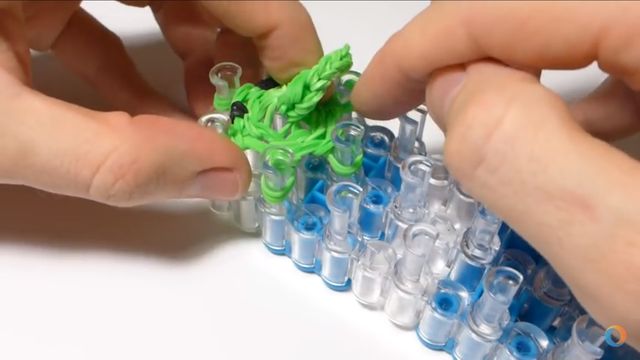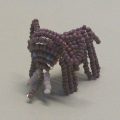
How to weave an elephant from rubber bands / Toys with own hands, patterns, video, MK
Lovely elephant of rubber bands. We will weave from the bands Rainbow Loom Band.
Lesson on weaving an elephant from Sergei
To make an elephant of rubber bandshook and a special machine for weaving. It consists of three rows, the middle row is slightly pushed to the left. The open part of the columns is directed to the right. Procedure for manipulation:
- The first rubber band is wound on the hook four times.
- The second is doubled, put on the middle finger of the left hand.
- Hook the elastic band, put on the middle finger, thread on it twisted four times the first elastic, left in the middle.
- Thread the hook into the second free loop so that the twisted elastic band is in the middle, and the hook was threaded into both hinges (the ends of the folded rubber band twice).
- The next elastic band is again twisted on the middlethe finger of the left hand is doubled, crocheted and threaded onto the existing workpiece. Grip the free end, so that the hook again goes into two loops, in the middle hung a wicker construction.
- Manipulation is carried out three times. It will be a trunk.
- Take three gum, one end of it is put on the hook, thread the existing workpieces, pick up the other end of the rubber bands. Obtain a thickening - the transition from the trunk to the muzzle of the elephant.
- Then take five elastics, perform a similar manipulation.
- The next two gums are threaded through the loops on the hook. The construction is applied to the first and third columns of the second row of the machine. The trunk must be on the second column of the row.
- Take two more gums and pass them throughten loops of the last row of the trunk, parallel to the previous two elastic bands. Free ends are cast on the first column of the far row and the second column of the near row.
- Take another pair, perform a similar manipulation, loose ends are put on the second column of the far row and the first column of the near. It turns out a six-pointed design with a trunk in the center.
- The next two bands are put on a pair of adjacent free columns. The new pair is thrown in sequence on the occupied and free columns and so on in a circle, until the circle closes.
- Hook the two lower gums of each column, throw over the top four and throw inside the structure (to the trunk).
- Create eyes. In order to use two black gum. One of them is wound in four turns on the hook. Throw the construction on two green rubber bands. Pass the hook to the free ends of the green rubber bands. The resulting blank is put on the first columns of the central and near rows.
- The second eye is created in the same way. They put it on the first columns of the middle and long rows. To complete the series, two more gums are inserted into the remaining columns, so that one end hits the occupied column, the second ends up on the free one.
- The lower row, consisting of four elastics, is thrown into the center of the circle to the trunk.

Creating ears:
- Use the free columns of the machine. On the adjacent columns in the middle and near row two rubber bands are put on. On the same column in the middle row and adjacent in the far one, two more elastic bands are put on.
- In the first row, on the occupied and adjacent right, a free column is put on again with two rubber bands. This manipulation is carried out thrice in the near row.
- In the back row two rubber bands are worn on the neighboringcolumns, the next two - on the occupied column in the far and free in the middle row. A design similar to the letter "P" is obtained. Another pair of rubber bands are put on occupied and loose columns in the center row. Then connect the near and middle rows with new elastic bands, thereby closing the entire structure.
- Two rubber bands are put on the fourth and third columns on the right, and also from the third to the second. After that, two more gums are put on the third column of each row. It turns out a triangle.
- On the first column of the near row,elastic, twist four times. Lower the hook into the column, grab the lowest row and throw it on the column in the reverse order with respect to the donning. Such manipulations are performed with all columns of the construction. Loops on the last column are held with a finger. Alternately remove the rubber bands from all the columns, getting the workpiece for the ear. On the last column, a pair of rubber bands pass through the loops, so the structure does not fall apart.
- The second ear of the elephant is created in the same way.
- The ears are placed on the same columns, where the blanks with the eyes were poured.

Creation of legs
The finiteness of the elephant calf is created by analogy withtrunk. Only the number of used elastics in each row is the same. Legs fold on the columns of the central and near (central and distant) rows, attaching with loops.
- After that, the four lower gums on each column are thrown into the structure.
- Throw the next row in a circle, again every four layers are thrown inside.
- Manipulation is repeated four times.
- After creating the workpiece for the two hind legs in analogy with the forelimbs.
- Fasten the hind legs to the columns of the middle and near (middle and far) rows. The same, on which the front legs were attached.
- Field put on a circle for a pair of elastics, throw the lower rows inside. Manipulation is repeated twice.
- The construction is removed from the machine using a hook. All loose loops must remain on the hook.
- Capture the crochet of two new rubber bands and gently pass through the free loops of the structure.
- One of the protruding loops is hidden inside the structure, the second is threaded so that it finds itself in the center of the elephant's priests. A tail is formed from it.
 The elephant is ready. In this way, animals of different colors can be made without significant investment in materials.
The elephant is ready. In this way, animals of different colors can be made without significant investment in materials.


